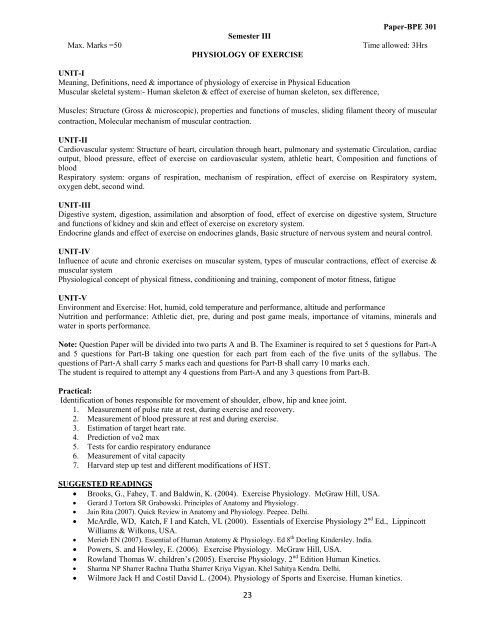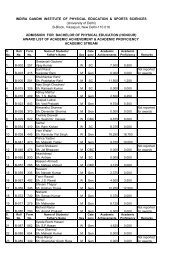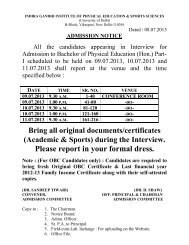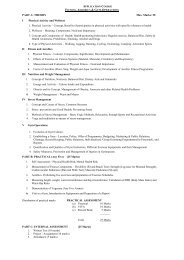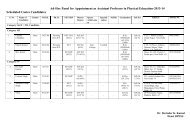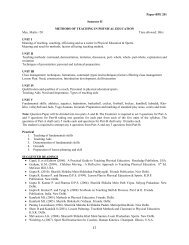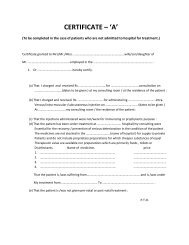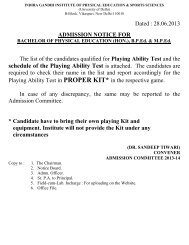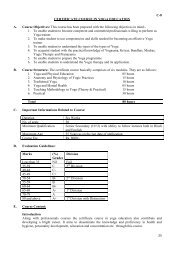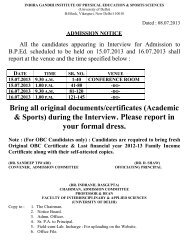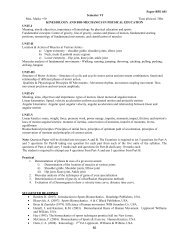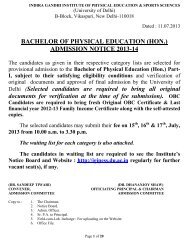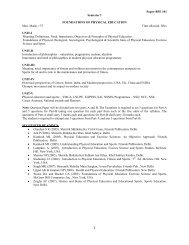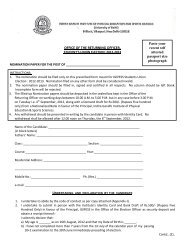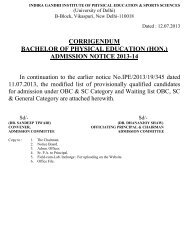Semester III - Indira Gandhi Institute of Physical Education and ...
Semester III - Indira Gandhi Institute of Physical Education and ...
Semester III - Indira Gandhi Institute of Physical Education and ...
Create successful ePaper yourself
Turn your PDF publications into a flip-book with our unique Google optimized e-Paper software.
Max. Marks =50<br />
<strong>Semester</strong> <strong>III</strong><br />
PHYSIOLOGY OF EXERCISE<br />
Paper-BPE 301<br />
Time allowed: 3Hrs<br />
UNIT-I<br />
Meaning, Definitions, need & importance <strong>of</strong> physiology <strong>of</strong> exercise in <strong>Physical</strong> <strong>Education</strong><br />
Muscular skeletal system:- Human skeleton & effect <strong>of</strong> exercise <strong>of</strong> human skeleton, sex difference,<br />
Muscles: Structure (Gross & microscopic), properties <strong>and</strong> functions <strong>of</strong> muscles, sliding filament theory <strong>of</strong> muscular<br />
contraction, Molecular mechanism <strong>of</strong> muscular contraction.<br />
UNIT-II<br />
Cardiovascular system: Structure <strong>of</strong> heart, circulation through heart, pulmonary <strong>and</strong> systematic Circulation, cardiac<br />
output, blood pressure, effect <strong>of</strong> exercise on cardiovascular system, athletic heart, Composition <strong>and</strong> functions <strong>of</strong><br />
blood<br />
Respiratory system: organs <strong>of</strong> respiration, mechanism <strong>of</strong> respiration, effect <strong>of</strong> exercise on Respiratory system,<br />
oxygen debt, second wind.<br />
UNIT-<strong>III</strong><br />
Digestive system, digestion, assimilation <strong>and</strong> absorption <strong>of</strong> food, effect <strong>of</strong> exercise on digestive system, Structure<br />
<strong>and</strong> functions <strong>of</strong> kidney <strong>and</strong> skin <strong>and</strong> effect <strong>of</strong> exercise on excretory system.<br />
Endocrine gl<strong>and</strong>s <strong>and</strong> effect <strong>of</strong> exercise on endocrines gl<strong>and</strong>s, Basic structure <strong>of</strong> nervous system <strong>and</strong> neural control.<br />
UNIT-IV<br />
Influence <strong>of</strong> acute <strong>and</strong> chronic exercises on muscular system, types <strong>of</strong> muscular contractions, effect <strong>of</strong> exercise &<br />
muscular system<br />
Physiological concept <strong>of</strong> physical fitness, conditioning <strong>and</strong> training, component <strong>of</strong> motor fitness, fatigue<br />
UNIT-V<br />
Environment <strong>and</strong> Exercise: Hot, humid, cold temperature <strong>and</strong> performance, altitude <strong>and</strong> performance<br />
Nutrition <strong>and</strong> performance: Athletic diet, pre, during <strong>and</strong> post game meals, importance <strong>of</strong> vitamins, minerals <strong>and</strong><br />
water in sports performance.<br />
Note: Question Paper will be divided into two parts A <strong>and</strong> B. The Examiner is required to set 5 questions for Part-A<br />
<strong>and</strong> 5 questions for Part-B taking one question for each part from each <strong>of</strong> the five units <strong>of</strong> the syllabus. The<br />
questions <strong>of</strong> Part-A shall carry 5 marks each <strong>and</strong> questions for Part-B shall carry 10 marks each.<br />
The student is required to attempt any 4 questions from Part-A <strong>and</strong> any 3 questions from Part-B.<br />
Practical:<br />
Identification <strong>of</strong> bones responsible for movement <strong>of</strong> shoulder, elbow, hip <strong>and</strong> knee joint.<br />
1. Measurement <strong>of</strong> pulse rate at rest, during exercise <strong>and</strong> recovery.<br />
2. Measurement <strong>of</strong> blood pressure at rest <strong>and</strong> during exercise.<br />
3. Estimation <strong>of</strong> target heart rate.<br />
4. Prediction <strong>of</strong> vo2 max<br />
5. Tests for cardio respiratory endurance<br />
6. Measurement <strong>of</strong> vital capacity<br />
7. Harvard step up test <strong>and</strong> different modifications <strong>of</strong> HST.<br />
SUGGESTED READINGS<br />
Brooks, G., Fahey, T. <strong>and</strong> Baldwin, K. (2004). Exercise Physiology. McGraw Hill, USA.<br />
Gerard J Tortora SR Grabowski. Principles <strong>of</strong> Anatomy <strong>and</strong> Physiology.<br />
Jain Rita (2007). Quick Review in Anatomy <strong>and</strong> Physiology. Peepee. Delhi.<br />
McArdle, WD, Katch, F I <strong>and</strong> Katch, VL (2000). Essentials <strong>of</strong> Exercise Physiology 2 nd Ed., Lippincott<br />
Williams & Wilkons, USA.<br />
Merieb EN (2007). Essential <strong>of</strong> Human Anatomy & Physiology. Ed 8 th Dorling Kindersley. India.<br />
Powers, S. <strong>and</strong> Howley, E. (2006). Exercise Physiology. McGraw Hill, USA.<br />
Rowl<strong>and</strong> Thomas W. children’s (2005). Exercise Physiology. 2 nd Edition Human Kinetics.<br />
Sharma NP Sharrer Rachna Thatha Sharrer Kriya Vigyan. Khel Sahitya Kendra. Delhi.<br />
Wilmore Jack H <strong>and</strong> Costil David L. (2004). Physiology <strong>of</strong> Sports <strong>and</strong> Exercise. Human kinetics.<br />
23
Paper-BPE 302<br />
<strong>Semester</strong> <strong>III</strong><br />
Max. Marks =50<br />
Time allowed: 3Hrs<br />
HEALTH EDUCATION, FIRST AID & REHABILITATION<br />
Unit-I<br />
Health-meaning, dimensions <strong>of</strong> health <strong>and</strong> their interrelationships, importance <strong>of</strong> health for individual, family,<br />
community <strong>and</strong> nation; factors influencing health, spectrum <strong>of</strong> health<br />
Health <strong>Education</strong>- meaning, scope, aims <strong>and</strong> objectives, principles, methods <strong>and</strong> media used in health education<br />
Hygiene- personal hygiene, food hygiene, environmental hygiene-meaning, need <strong>and</strong> importance; associated<br />
practices related to maintenance <strong>and</strong> promotion <strong>of</strong> health<br />
Unit-II<br />
Foods <strong>and</strong> Nutrition- Misconceptions about food, essential body nutrients- functions, food sources, balanced diet,<br />
diet prescription<br />
Communicable <strong>and</strong> Non-communicable diseases- meaning, distinction between communicable <strong>and</strong> noncommunicable<br />
diseases. Communicable diseases- their mode <strong>of</strong> spread <strong>and</strong> prevention <strong>of</strong> diarrhea diseases, typhoid,<br />
malaria, STD Respiratory disease ; non-communicable diseases- causes <strong>and</strong> prevention <strong>of</strong> diabetes, CVD, cancers,<br />
renal diseases <strong>and</strong> respiratory diseases.<br />
Unit-<strong>III</strong><br />
Contemporary health problems <strong>of</strong> college youth- Alcohol, drugs, use <strong>of</strong> tobacco (chewing, sniffing, smoking)- their<br />
harmful effects substance abuse management<br />
Population education- importance <strong>of</strong> small family, methods <strong>of</strong> controlling conception, signs <strong>and</strong> symptoms <strong>of</strong><br />
pregnancy, home <strong>and</strong> hospital delivery, care <strong>of</strong> the infant, importance <strong>of</strong> breast feeding, immunization, oral<br />
rehydration therapy<br />
National health programmes- components <strong>of</strong> existing national health programmes<br />
Unit-IV<br />
Definition <strong>of</strong> first aid, DRABCH <strong>of</strong> first aid, CPR, first aid for, hemorrhage, fractures, sprain <strong>and</strong> strain (Price),<br />
drowing snake bite, poisoning, heat stroke <strong>and</strong> heat exhaustion<br />
Internationals health agencies- WHO, UNICEF, Red Cross- their constitution <strong>and</strong> role in promoting health<br />
Unit-V<br />
Rehabilitation – definition, physical, mental <strong>and</strong> psychological rehabilitation.<br />
Rehabilitation Modalities – cold, heat, water, radiation, Hydrotherapy, cryotherapy, thermotherapy – superficial heat<br />
– I R Lamp, Wax bath, deep heat- short wave diathermy, microwave diathermy, u/s therapy, inferential therapy,<br />
TENS, nerve muscle stimulator.<br />
Note: Question Paper will be divided into two parts A <strong>and</strong> B. The Examiner is required to set 5 questions for Part-A<br />
<strong>and</strong> 5 questions for Part-B taking one question for each part from each <strong>of</strong> the five units <strong>of</strong> the syllabus. The<br />
questions <strong>of</strong> Part-A shall carry 5 marks each <strong>and</strong> questions for Part-B shall carry 10 marks each.<br />
The student is required to attempt any 4 questions from Part-A <strong>and</strong> any 3 questions from Part-B.<br />
Practical<br />
1. A visit to – International health agency <strong>and</strong>/or Government/NGO related to health promotion activities<br />
2. Study <strong>of</strong> health programmes/s<br />
3. Prescription <strong>of</strong> diet<br />
4. Determination <strong>of</strong> calorie value <strong>of</strong> food<br />
5. Identification <strong>of</strong> various methods <strong>of</strong> contraceptives<br />
6. Collection <strong>of</strong> material for substance abuse control<br />
7. Immunization schedule<br />
SUGGESTED READINGS<br />
Anspaugh DJ Ezell G <strong>and</strong> Goodman KN (2006). Teaching Today’s Health. Mosby Publishers. Chicago.<br />
USA.<br />
Balayan D (2007). Swasthya Shiksha Evam Prathmik Chikitsa. Khel Sahitya. Delhi.<br />
Chopra D <strong>and</strong> D Simon (2001). Grow Younger, Live Longer: 10 Steps to Reverse Aging. Three Rivers<br />
Press. New York. USA.<br />
Dewan AP (1996). School Health Manual. Nature Cure <strong>and</strong> Yoga Health Centre. New Delhi.<br />
Dixit Suresh (2006). Swasthya Shiksha. Sports Publication. Delhi.<br />
24
Floyd PA SE Mimms <strong>and</strong> C Yeilding (2003). Personal Health: Perspectives <strong>and</strong> Lifestyles. Thomson Wads<br />
Worth. Belmont. California. USA.<br />
Hales D (2005). An Invitation to Health. Thomson-Wadsworth, Belmont. California. USA.<br />
Donatelle RJ (2005). Health the Basics. Sixth Edition. Oregon State University.<br />
Snehlata (2006). Shareer, Vigyan Evam Swasthya Raksha. Discovery Pub. House s. New Delhi.<br />
Uppal AK & Gautam GP (2008). Health & <strong>Physical</strong> <strong>Education</strong>. Friends Publication. New Delhi.<br />
Park K (2007). Park’s Text Book <strong>of</strong> Preventive & Social Medicine. Banarsi Das Bhanot & Company. Delhi.<br />
25
Max. Marks =50<br />
<strong>Semester</strong> <strong>III</strong><br />
GAME OF SPECIALIZATION – ATHLETICS<br />
Paper-BPE 303 (i)<br />
Time allowed: 3Hrs<br />
Unit-I<br />
Introduction to athletics, Olympics <strong>and</strong> non- Olympics events<br />
Structure, Constitution <strong>and</strong> functions <strong>of</strong> IOC (International Olympic Committee) AAA (Athletics Association <strong>of</strong><br />
Area) OCA (Olympic Council <strong>of</strong> Area)<br />
Marking <strong>of</strong> various areanas <strong>of</strong> field events –long jump, triple jump, shot put <strong>and</strong> discuss throw<br />
Unit-II<br />
Protocol <strong>and</strong> procedure <strong>of</strong> athletics championship<br />
Organisation <strong>and</strong> management <strong>of</strong> athletics meet<br />
Ceremonies – Opening Ceremony, victory <strong>and</strong> closing ceremony<br />
Unit-<strong>III</strong><br />
Brief background techniques, training <strong>and</strong> important motor-components <strong>of</strong> the following events:<br />
Middle <strong>and</strong> long distance running , Javelin throw <strong>and</strong> Hammer throw, High Jump <strong>and</strong> Pole Vault, Relay races<br />
(4x100m, 4x400m)<br />
Unit-IV<br />
Tactics <strong>and</strong> strategies <strong>of</strong> the concern events, Athletics training for children <strong>and</strong> women, Psychological <strong>and</strong> social<br />
factors <strong>of</strong> athletics performance<br />
Unit-V<br />
Athletics training load, form <strong>of</strong> load, factors <strong>of</strong> load, load <strong>and</strong> adaptation<br />
Various training methods- continuous, interval, repetition, slow-fast <strong>and</strong> descending <strong>and</strong> ascending training methods<br />
Note: Question Paper will be divided into two parts A <strong>and</strong> B. The Examiner is required to set 5 questions for Part-A<br />
<strong>and</strong> 5 questions for Part-B taking one question for each part from each <strong>of</strong> the five units <strong>of</strong> the syllabus. The<br />
questions <strong>of</strong> Part-A shall carry 5 marks each <strong>and</strong> questions for Part-B shall carry 10 marks each.<br />
The student is required to attempt any 4 questions from Part-A <strong>and</strong> any 3 questions from Part-B.<br />
Practical<br />
1. Technical training <strong>and</strong> practice <strong>of</strong> following<br />
2. Middle <strong>and</strong> long distance running<br />
3. Javelin throw <strong>and</strong> Hammer throw<br />
4. High Jump <strong>and</strong> Pole Vault<br />
5. Relay races (4x100m, 4x400m)<br />
SUGGESTED READINGS<br />
Chauhan BS (1999). Khel Jagat Mein Athletics. A.P. Pub, Jal<strong>and</strong>har.<br />
Fox EL (1998). Physiological Basis <strong>of</strong> <strong>Physical</strong> <strong>Education</strong> <strong>and</strong> Athletics Brown Pub.<br />
Frost RB <strong>and</strong> others (1992). Administration <strong>of</strong> <strong>Physical</strong> <strong>Education</strong> <strong>and</strong> Athletics. Universal Book, Delhi.<br />
Gothi E (1997). Teaching & Coaching Athletics. Sport Pub., New Delhi.<br />
Grant, S. <strong>and</strong> Lloyd, E. (2006). Training <strong>and</strong> Performance in difficult environments : A Guide for<br />
competitive Athletes. Crowood Press, USA.<br />
Knight T <strong>and</strong> Troop N (1988). Sackville Illustrated Dictionary <strong>of</strong> Athletics, Jackvillie,<br />
Renwick GR (2001). Play Better Athletics. Sports Pub, Delhi.<br />
Shrivastav AK (1997). Athletics. S & S Parkashan. Amravati.<br />
Singh Granth (1998). Track <strong>and</strong> Field Athletics. Ashoka, Delhi.<br />
Thani (1995). Skills <strong>and</strong> Tactics Track Athletics. Sports Pub. Delhi.<br />
Warden P (1990). Take Up Athletics. Springfield Books Ltd.<br />
Weaver T (1988). Personal Best : Athletics. Harper Collins. London.<br />
26
Paper-BPE 303 (ii)<br />
Max. Marks =50<br />
<strong>Semester</strong> <strong>III</strong><br />
GAME OF SPECIALIZATION – BASKETBALL<br />
Time allowed: 3Hrs<br />
UNIT-I<br />
Principles <strong>and</strong> objectives <strong>of</strong> coaching, Techniques <strong>of</strong> coaching – pep talk, coaching- pre match, during <strong>and</strong> post<br />
match, individual <strong>and</strong> group coaching<br />
UNIT-II<br />
Psychological qualities <strong>and</strong> preparation <strong>of</strong> a basketball player, Team system <strong>and</strong> tactical training, Offensive system<br />
in play, Defense system in play<br />
UNIT-<strong>III</strong><br />
Individual, Diet <strong>and</strong> nutrition for a basketball player. Construction <strong>of</strong> basketball court<br />
UNIT-IV<br />
Principles <strong>of</strong> load <strong>and</strong> adaptation, Fatigue, recovery <strong>and</strong> super compensation, Overload <strong>and</strong> its management<br />
UNIT-V<br />
Ankle sprain, jammed thumb, shoulder dislocation, wrist twist, rib injuries, Preventive <strong>and</strong> safety measures,<br />
Rehabilitation<br />
Note: Question Paper will be divided into two parts A <strong>and</strong> B. The Examiner is required to set 5 questions for Part-A<br />
<strong>and</strong> 5 questions for Part-B taking one question for each part from each <strong>of</strong> the five units <strong>of</strong> the syllabus. The<br />
questions <strong>of</strong> Part-A shall carry 5 marks each <strong>and</strong> questions for Part-B shall carry 10 marks each.<br />
The student is required to attempt any 4 questions from Part-A <strong>and</strong> any 3 questions from Part-B.<br />
PRACTICAL<br />
1. Dribbling Drill<br />
2. Speed work<br />
3. Endurance Training<br />
4. Match Practice<br />
SUGGESTED READINGS<br />
Ambler V (1984). How to Play Basket Ball. Paper Balls, Delhi.<br />
Cluck, B. (1998) Play Better Basketball : Winning Techniques <strong>and</strong> Strategies. 2 nd Ed. McGraw Hill, USA.<br />
Jain Naveen (2003). Play <strong>and</strong> Learn Basket Ball. Khel Sahitya Kendra, New Delhi.<br />
Nat B. B (1997). Conditioning Coaches Association. NBA Power Conditioning, Human Kinetics.<br />
Sharma OP (2003). Basket Ball Skills <strong>and</strong> Rules. Khel Sahitya Kendra, Delhi.<br />
Thani Lokesh (1995). Skills & Tactics <strong>of</strong> Basket Ball. Sport Pub, New Delhi.<br />
Thani Yograj (2002). Coaching Successfully Basket Ball. Sports Publisher, Delhi.<br />
27
Paper-BPE 303 (iii)<br />
<strong>Semester</strong> <strong>III</strong><br />
Max. Marks =50<br />
Time allowed: 3Hrs<br />
GAME OF SPECIALIZATION – BADMINTON<br />
UNIT-I<br />
Important motor components, Structure <strong>and</strong> process for improvement <strong>of</strong> performance, Various training methods <strong>and</strong><br />
principles <strong>of</strong> training load, Causes <strong>and</strong> symptoms <strong>of</strong> overload, Management <strong>of</strong> overload<br />
UNIT-II<br />
Anatomical considerations, Physiological considerations, Biomechanical considerations, Psychological<br />
consideration, Scientific research reviews<br />
UNIT-<strong>III</strong><br />
Long term <strong>and</strong> short term planning for competition, Cyclic process <strong>of</strong> training : micro, meso <strong>and</strong> macro cycles<br />
Preparation <strong>of</strong> training schedules, Tactical efficiency<br />
UNIT-IV<br />
Introduction, importance <strong>of</strong> test, measurement <strong>and</strong> evaluation in badminton, Fitness tests, Skill tests<br />
UNIT-V<br />
Means & methods, Teaching lessons, process <strong>of</strong> classroom teaching, Preparation <strong>of</strong> teaching lesson-plans :<br />
characteristics & principles, Stages <strong>of</strong> teaching, Use <strong>of</strong> teaching aids<br />
Note: Question Paper will be divided into two parts A <strong>and</strong> B. The Examiner is required to set 5 questions for Part-A<br />
<strong>and</strong> 5 questions for Part-B taking one question for each part from each <strong>of</strong> the five units <strong>of</strong> the syllabus. The<br />
questions <strong>of</strong> Part-A shall carry 5 marks each <strong>and</strong> questions for Part-B shall carry 10 marks each.<br />
The student is required to attempt any 4 questions from Part-A <strong>and</strong> any 3 questions from Part-B.<br />
PRACTICALS<br />
1. Practical applications <strong>of</strong> tactics <strong>and</strong> strategies<br />
2. Training means for development <strong>and</strong> measurement <strong>of</strong> strength, speed, endurance, flexibility <strong>and</strong> coordinative<br />
abilities<br />
3. Observing <strong>and</strong> assessing the video/tournament recording/movie <strong>and</strong> preparing a report<br />
4. Teaching lessons<br />
SUGGESTED READINGS<br />
<br />
<br />
<br />
<br />
<br />
<br />
<br />
<br />
<br />
<br />
Bloss M.V & Hales RS (1994). Badminton. WC Brown<br />
Downey J (1990). How to Coach Badminton. Collins Pub. London.<br />
Grice, T. (2007). Badminton : Steps to Success : 2 nd Ed. Human Kinetics, USA.<br />
Jain D (2001). Teaching <strong>and</strong> Coaching –Badminton. Khel S.K. Delhi<br />
Kumar A (2003). Badminton. Discovery, New Delhi.<br />
Narang P (2005). Play <strong>and</strong> Learn Badminton. Khel Sahitaya Kendra<br />
Seaman, J. (2009). Badminton Revisited. J.R. Books Ltd.<br />
Singh MK (2006). A to Z Badminton. Friends Pub. New Delhi.<br />
Singh MK (2007). Comprehensive Badminton. Friends Pub. New Delhi.<br />
Talbot Derlk (1989). Top Coach Badminton. Britain: Q.A. Press<br />
28
Max. Marks =50<br />
<strong>Semester</strong> <strong>III</strong><br />
GAME OF SPECIALIZATION – CRICKET<br />
Paper-BPE 303 (iv)<br />
Time allowed: 3Hrs<br />
UNIT-I<br />
Principles <strong>and</strong> objectives <strong>of</strong> coaching, Techniques <strong>of</strong> coaching – pep talk, coaching- pre-match, during <strong>and</strong> postmatch,<br />
individual <strong>and</strong> group coaching,<br />
UNIT- II<br />
Coaching schedule – seasonal, daily, weekly, monthly <strong>and</strong> yearly, Talent-identification to select the winning<br />
combination,<br />
UNIT-<strong>III</strong><br />
Long-term <strong>and</strong> short-term preparation for the decisive cricket competitions, Psychological qualities <strong>and</strong> preparation<br />
<strong>of</strong> a cricketer, Team system <strong>and</strong> tactical training, Team building<br />
UNIT-IV<br />
Offensive system in play, Defense system in play Individual group <strong>and</strong> team tactics, Diet <strong>and</strong> nutrition for a<br />
cricketer, The coordination among the coach, doctor, psychologist <strong>and</strong> players<br />
UNIT-V<br />
Ankle sprain, finger injuries, shoulder dislocation, knee displacement, rotator’s cuff , Preventive <strong>and</strong> safety<br />
measures, First-aid <strong>and</strong> Rehabilitation<br />
Note: Question Paper will be divided into two parts A <strong>and</strong> B. The Examiner is required to set 5 questions for Part-A<br />
<strong>and</strong> 5 questions for Part-B taking one question for each part from each <strong>of</strong> the five units <strong>of</strong> the syllabus. The<br />
questions <strong>of</strong> Part-A shall carry 5 marks each <strong>and</strong> questions for Part-B shall carry 10 marks each.<br />
The student is required to attempt any 4 questions from Part-A <strong>and</strong> any 3 questions from Part-B.<br />
PRACTICALS<br />
1. Practical efficiency in performance & demonstration <strong>of</strong> different advanced techniques<br />
Basic Skills <strong>and</strong> Techniques:<br />
Batting - forward defense, backward defense, all types <strong>of</strong> drives, glance, cut, pull, sweep<br />
Bowling - medium pace, leg spin, <strong>of</strong>f spin <strong>and</strong> their improvisation, Fielding - catching, ground<br />
fielding, close <strong>and</strong> deep fielding, Wicket-keeping<br />
2. Practical application <strong>of</strong> different tactics<br />
3. Test, measurement & evaluation<br />
(a) Skill tests (throwing ability, running between wicket, target hitting)<br />
(b) Tests for different fitness components<br />
4. Coaching lesson - 5 (five) internal lessons<br />
SUGGESTED READINGS<br />
<br />
<br />
<br />
<br />
<br />
<br />
<br />
<br />
<br />
<br />
<br />
Amarnath M (1996). Learn to Play Good Cricket. Ubspd, New Delhi.<br />
Chugh GD (1993). Laws <strong>of</strong> Cricket. D.V.S.Pub. New Delhi.<br />
Dellor R (1990). How to Coach Cricket. M<strong>and</strong>ola, London.<br />
Goodway, K. (2002). Your Cricket Coach. Human <strong>and</strong> Rousseau Pvt. Ltd., USA.<br />
Jain R (2003). Play <strong>and</strong> Learn Cricket. K.S.K, New Delhi.<br />
Kutty S K (2003). Fielding Drills in Cricket. K.S.K, New Delhi.<br />
Jain R (2005). Play & Learn Cricket. Khel Sahitaya Kendra. Delhi.<br />
Sharangpani, RC (1992). Fitness Training in Cricket. Marine Sports. Bombay.<br />
Sharma P (2003). Cricket. Shyam Prakashan. Jaipur.<br />
Srivastava, A.K. (2007). How to Coach Cricket. Sports Publications, Delhi.<br />
Thani Vivek (1998). Coaching Cricket. Khel Sahitya Kendra. New Delhi.<br />
29
Max. Marks =50<br />
<strong>Semester</strong> <strong>III</strong><br />
Paper XI (a)<br />
GAME OF SPECIALIZATION – FOOTBALL<br />
Paper-BPE 303 (v)<br />
Time allowed: 3Hrs<br />
UNIT-I<br />
Principles <strong>and</strong> objectives <strong>of</strong> coaching, Techniques <strong>of</strong> coaching – pep talk, coaching- pre match, during <strong>and</strong> post<br />
match, individual <strong>and</strong> group coaching, Coaching schedule – seasonal, daily, weekly, monthly <strong>and</strong> yearly, Talent<br />
identification to select the winning combination – the <strong>of</strong>fense <strong>and</strong> the defense, Team building<br />
UNIT-II<br />
Long - term <strong>and</strong> short - term preparation for the decisive football competitions, Psychological qualities <strong>and</strong><br />
preparation <strong>of</strong> a football player,<br />
UNIT-<strong>III</strong><br />
Team system <strong>and</strong> tactical training-Offensive system in play, Defense system in play, Dribbling <strong>and</strong> reception<br />
pattern, Individual , group <strong>and</strong> team tactics<br />
UNIT-IV<br />
Describe major muscles used in the basic skills <strong>of</strong> games<br />
UNIT-V<br />
Ankle sprain, finger injuries, shoulder dislocation, knee displacement <strong>and</strong> head injuries, Preventive <strong>and</strong> safety<br />
measures, First-aid <strong>and</strong> Rehabilitation<br />
Note: Question Paper will be divided into two parts A <strong>and</strong> B. The Examiner is required to set 5 questions for Part-A<br />
<strong>and</strong> 5 questions for Part-B taking one question for each part from each <strong>of</strong> the five units <strong>of</strong> the syllabus. The<br />
questions <strong>of</strong> Part-A shall carry 5 marks each <strong>and</strong> questions for Part-B shall carry 10 marks each.<br />
The student is required to attempt any 4 questions from Part-A <strong>and</strong> any 3 questions from Part-B.<br />
PRACTICAL<br />
1. Tackling the ball – basic, slide, shoulder charge<br />
2. Feinting – with the ball, without the ball, with an opponent behind <strong>and</strong> alongside the dribble<br />
3. Correct skill <strong>of</strong> throw in – throwing a ball, faults occurring, required instruction<br />
4. Goal keeping - throwing a ball with one h<strong>and</strong>, rolling the ball along the ground, ground kick, air kick<br />
5. Penalty kick<br />
SUGGESTED READINGS<br />
Kumar N (2003). Play <strong>and</strong> Learn Football. K.S.K. New Delhi.<br />
Lau SK (1995). Encyclopedia <strong>of</strong> Football. Sport Pub. Delhi.<br />
Reilly T (1988). Science <strong>and</strong> Football. E.N. Sport Ltd. London.<br />
Sharma OP (2001). Teaching <strong>and</strong> Coaching –Football. Khel S.K. Delhi.<br />
Shellito K (1988). Personal Best Football. William Collins & Sons. London.<br />
Thani Y(2002). Coaching Successfully Football. K.S.K. New Delhi.<br />
Williams J (1988). The Roots <strong>of</strong> Football. London.<br />
Wirhed R (1992). Training to Win Football. Wolfe Pub. London.<br />
30
Paper-BPE 303 (vi)<br />
<strong>Semester</strong> <strong>III</strong><br />
Max. Marks =50<br />
Time allowed: 3Hrs<br />
GAME OF SPECIALIZATION – GYMNASTICS<br />
UNIT-I<br />
Psychological preparation <strong>of</strong> a gymnast-Principles <strong>and</strong> methods <strong>of</strong> development <strong>of</strong> mental pre-requisite for training,<br />
Mental preparation for competition, Mental training during competition, Attention <strong>and</strong> its role in gymnastics<br />
Children training in gymnastics-Aims <strong>and</strong> objectives, Principles <strong>and</strong> procedure <strong>of</strong> training, Construction <strong>of</strong> an<br />
exercise/routines for various levels <strong>of</strong> competitions<br />
UNIT-II<br />
Nutrition in gymnastics-Meaning, definition <strong>and</strong> classification <strong>of</strong> nutrition, Basic components <strong>of</strong> nutrition, Energy<br />
requirements <strong>and</strong> body composition in gymnastics, Role <strong>of</strong> diet in pre-competition, during competition <strong>and</strong> <strong>of</strong>fsession<br />
phases, Fluid <strong>and</strong> its role in gymnastics-Pre-session, In-session, During competition, Off-session<br />
UNIT-<strong>III</strong><br />
Specification <strong>of</strong> gymnastics apparatus (Artistic & Rhythmic)<br />
UNIT-IV<br />
Sports Aerobics Gymnastics-Group-A : Dynamic strength, Group-B : Static strength, Group-C : Jumps <strong>and</strong> leaps,<br />
Group-D : Balance <strong>and</strong> flexibility, Sports Acrobatic Gymnastics-Mixed, Men double, Women double, Quadrapt –<br />
four men<br />
UNIT-V<br />
Pr<strong>of</strong>essional preparation in Gymnastics, Outline a proposal <strong>of</strong> starting gymnastics in school, college <strong>and</strong> club, Prepare a<br />
detailed orientation/clinic/workshop in gymnastics<br />
Note: Question Paper will be divided into two parts A <strong>and</strong> B. The Examiner is required to set 5 questions for Part-A<br />
<strong>and</strong> 5 questions for Part-B taking one question for each part from each <strong>of</strong> the five units <strong>of</strong> the syllabus. The<br />
questions <strong>of</strong> Part-A shall carry 5 marks each <strong>and</strong> questions for Part-B shall carry 10 marks each.<br />
The student is required to attempt any 4 questions from Part-A <strong>and</strong> any 3 questions from Part-B.<br />
PRACTICAL<br />
1. Sports Aerobics Gymnastics-Group-A : Dynamic strength, Group-B : Static strength, Group-C : Jumps <strong>and</strong><br />
leaps<br />
2. Group-D : Balance <strong>and</strong> flexibility<br />
3. Assignment/Project-Pr<strong>of</strong>essional preparation in gymnastics, Outline a proposal <strong>of</strong> starting gymnastics in<br />
school, college <strong>and</strong> club, Prepare a detailed orientation/clinic/workshop in gymnastics, Observing <strong>and</strong><br />
assessing the video/tournament recording/movie <strong>and</strong> preparing a report<br />
4. Teaching lessons (preparation, stages <strong>of</strong> teaching <strong>and</strong> use <strong>of</strong> teaching aids)<br />
SUGGESTED READINGS<br />
<br />
<br />
<br />
<br />
<br />
<br />
<br />
<br />
<br />
<br />
Chakraborty S <strong>and</strong> Sharma L (1995). Fundamental <strong>of</strong> Gymnastics. D.V.S. Pub. New Delhi.<br />
Chakraborty S (1995). Fundamental <strong>of</strong> Gymnastics. DVS Pub. New Delhi.<br />
Chakraborty S (1998). Women's Gymnastics. Friends Pub. Delhi.<br />
Federation Int. De Gymnastics (2005). Code <strong>of</strong> Points Trampoline Gymnastics<br />
Derry G (1988). Personal Best Gymnastics. Willionm Colliv. London.<br />
Harvey FJ (1998). <strong>Physical</strong> Exercises & Gymnastics. Khel Sahitya. New Delhi.<br />
Jain R (2005). Play <strong>and</strong> Learn Gymnastics. Khel Sahitaya Kendra. New Delhi.<br />
Pearson D (1991). Play The Game Gymnastics. Ward Lock. London.<br />
Smither Graham (1980). Behing The Scence <strong>of</strong> Gymnastics. London.<br />
Tur<strong>of</strong>f Fred (1991). Artistic Gymnastics. C. Brown. U.S.A.<br />
31
Max. Marks =50<br />
<strong>Semester</strong> <strong>III</strong><br />
GAME OF SPECIALIZATION – HANDBALL<br />
Paper-BPE 303 (vii)<br />
Time allowed: 3Hrs<br />
UNIT-I<br />
General <strong>and</strong> specific warm up, (cooling down <strong>and</strong> their physiological concepts) , specific motor components related<br />
to h<strong>and</strong>ball, their importance <strong>and</strong> development.<br />
UNIT-II<br />
Introduction to sports training, its importance <strong>and</strong> characteristics, training load, over load <strong>and</strong> adaptation, principles<br />
<strong>of</strong> training load<br />
UNIT-<strong>III</strong><br />
Officiating- Methods <strong>and</strong> importance <strong>of</strong> <strong>of</strong>ficiating, duties <strong>and</strong> responsibilities <strong>of</strong> <strong>of</strong>ficials<br />
UNIT-IV<br />
Tactical preparation- Attaching & defensive tactics, different types <strong>of</strong> group tactics & their principles, game<br />
strategies <strong>and</strong> system <strong>of</strong> play<br />
UNIT-V<br />
Psychological training- Importance <strong>and</strong> Methods <strong>of</strong> Psychological training, philosophical aspects <strong>of</strong> training <strong>and</strong><br />
coaching<br />
Note: Question Paper will be divided into two parts A <strong>and</strong> B. The Examiner is required to set 5 questions for Part-A<br />
<strong>and</strong> 5 questions for Part-B taking one question for each part from each <strong>of</strong> the five units <strong>of</strong> the syllabus. The<br />
questions <strong>of</strong> Part-A shall carry 5 marks each <strong>and</strong> questions for Part-B shall carry 10 marks each.<br />
The student is required to attempt any 4 questions from Part-A <strong>and</strong> any 3 questions from Part-B.<br />
Practical<br />
1. Court marking (dimensions)<br />
2. Team (players, substitutes, coaches)<br />
3. The <strong>of</strong>ficials (referee, table <strong>of</strong>ficials <strong>and</strong> their powers)<br />
4. Rules <strong>of</strong> contact (practical knowledge)<br />
5. Fast breaks<br />
6. Second waves<br />
7. Free throws<br />
8. Screen (at different positions)<br />
9. Peripheral vision<br />
10. Training <strong>of</strong> physical fitness components<br />
11. Exercise drill<br />
SUGGESTED READINGS<br />
Jain D (2003). Play & Learn H<strong>and</strong>ball. Khel Sahitya Kendra. New Delhi.<br />
Kumar A (1999). H<strong>and</strong>ball. Discovery Publishing House. New Delhi.<br />
Lohar AR (1998). H<strong>and</strong>ball Basic Technology. The Marine Sports Publishing Division. Bombay.<br />
Schmottlach N Mcmanama J (1997). <strong>Physical</strong> <strong>Education</strong> H<strong>and</strong>book. 9th Edition. Allyn & Bacon. London.<br />
32
Max. Marks =50<br />
<strong>Semester</strong> <strong>III</strong><br />
GAME OF SPECIALIZATION – HOCKEY<br />
Paper-BPE 303 (viii)<br />
Time allowed: 3Hrs<br />
UNIT-I<br />
General <strong>and</strong> specific warm up, cooling down & their physiological effect, specific motor components related to<br />
hockey, their importance <strong>and</strong> development.<br />
UNIT-II<br />
Introduction to sports training, its importance <strong>and</strong> characteristics, training load <strong>and</strong> adaptation, principles <strong>of</strong> training<br />
load<br />
UNIT-<strong>III</strong><br />
Officiating- Definition <strong>and</strong> importance, duties <strong>and</strong> responsibilities <strong>of</strong> hockey skills<br />
UNIT-IV<br />
Tactical preparation- Attaching & defensive tactics, their kinds & principles, game strategies- system <strong>of</strong> play<br />
UNIT-V<br />
Psychological training- Methods <strong>and</strong> importance <strong>of</strong> Psychological training, philosophical aspects <strong>of</strong> training <strong>and</strong><br />
coaching<br />
Note: Question Paper will be divided into two parts A <strong>and</strong> B. The Examiner is required to set 5 questions for Part-A<br />
<strong>and</strong> 5 questions for Part-B taking one question for each part from each <strong>of</strong> the five units <strong>of</strong> the syllabus. The<br />
questions <strong>of</strong> Part-A shall carry 5 marks each <strong>and</strong> questions for Part-B shall carry 10 marks each.<br />
The student is required to attempt any 4 questions from Part-A <strong>and</strong> any 3 questions from Part-B.<br />
PRACTICALS<br />
1. Drills to improve basic skill-hitting, receiving, shooting at goal post passing<br />
2. Attacking tactics- Attacking move from right <strong>and</strong> left side, interchange position, heading <strong>and</strong> shooting at<br />
goal<br />
3. Defensive tactics- Positioning <strong>of</strong> defenders, interchange position, man to man <strong>and</strong> zonal defense, defensive<br />
attack<br />
4. General <strong>and</strong> specific exercise for warming up <strong>and</strong> cooling down<br />
SUGGESTED READINGS<br />
Dubey HC (1999). Hockey. Discovery Publishing House. New Delhi.<br />
International Hockey Federation (2003). Rules <strong>of</strong> the Game <strong>of</strong> Hockey with Guidance for Players <strong>and</strong><br />
Umpires. International Hockey Federation. India.<br />
Jain D (2003). Hockey Skills & Rules. khel Sahitya Kendra . New Delhi.<br />
Narang P (2003). Play & Learn Hockey. Khel Sahitya Kendra. New Delhi.<br />
Thani Y(2002). Coaching Successfully Hockey. Sports Publication. Delhi.<br />
33
<strong>Semester</strong> <strong>III</strong><br />
Max. Marks =50<br />
GAME OF SPECIALIZATION – JUDO<br />
UNIT-I<br />
Important motor components, Structure <strong>and</strong> process <strong>of</strong> improvement <strong>of</strong> performance<br />
Paper-BPE 303 (ix)<br />
Time allowed: 3Hrs<br />
UNIT-II<br />
Principles <strong>of</strong> training load <strong>and</strong> various training methods, Causes, symptoms <strong>and</strong> management <strong>of</strong> overload<br />
UNIT-<strong>III</strong><br />
Long term <strong>and</strong> short term panning, main <strong>and</strong> build-up competitions, Preparation <strong>of</strong> training schedules, Tactical<br />
efficiency<br />
UNIT-IV<br />
Fitness tests, Skill tests, Knowledge tests, Assessment <strong>of</strong> performance for better efficiency or performance analysis<br />
UNIT-V<br />
Coaching a team, Organising a competition , Officiating in a competition, Conducting a workshop/seminar/clinic<br />
Note: Question Paper will be divided into two parts A <strong>and</strong> B. The Examiner is required to set 5 questions for Part-A<br />
<strong>and</strong> 5 questions for Part-B taking one question for each part from each <strong>of</strong> the five units <strong>of</strong> the syllabus. The<br />
questions <strong>of</strong> Part-A shall carry 5 marks each <strong>and</strong> questions for Part-B shall carry 10 marks each.<br />
The student is required to attempt any 4 questions from Part-A <strong>and</strong> any 3 questions from Part-B.<br />
PRACTICALS<br />
1. Practical applications <strong>of</strong> techniques <strong>and</strong> tactics<br />
2. Training means for development <strong>and</strong> measurement <strong>of</strong> strength, speed, endurance, flexibility <strong>and</strong><br />
coordinative abilities<br />
3. Observing <strong>and</strong> assessing the video/tournament recording/movie <strong>and</strong> preparing a report<br />
4. Teaching lessons<br />
SUGGESTED READINGS<br />
Caffary B (1992). Skilful Judo. A & C Black London.<br />
D<strong>and</strong>o J (1994). Play The Game Judo. Bl<strong>and</strong>ford Great Britain.<br />
Harrison EJ (2002). Coaching Successfully Judo. Sports Publishers. Delhi.<br />
Holme P (1995). Get to Gripe With Judo. Bl<strong>and</strong>ford. London.<br />
Holme P (1996). Competition Judo. Ward Lock. London.<br />
Jain D (2003). Play <strong>and</strong> Learn Judo. Khel Sahitaya Kendra. New Delhi.<br />
Kumar M (1994). Action Judo. Sport Publication. Delhi.<br />
Marwood D (1995). Critical Judo. A.I.T.B.S. Pub. New Delhi.<br />
34
Max. Marks =50<br />
<strong>Semester</strong> <strong>III</strong><br />
GAME OF SPECIALIZATION – KABADDI<br />
Paper-BPE 303 (x)<br />
Time allowed: 3Hrs<br />
UNIT-I<br />
Tactics & strategies in Kabaddi, Individual, group <strong>and</strong> team tactics,<br />
UNIT-II<br />
Long - term <strong>and</strong> short term preparation for the decisive Kabaddi competitions, Psychological qualities <strong>and</strong><br />
preparation <strong>of</strong> a Kabaddi player, Offensive system in play, Defense system in play, Raid <strong>and</strong> save pattern<br />
UNIT-<strong>III</strong><br />
Diet <strong>and</strong> nutrition for a Kabaddi player<br />
UNIT-IV<br />
Principles <strong>of</strong> load <strong>and</strong> adaptation, Fatigue, recovery <strong>and</strong> super – compensation, Overload <strong>and</strong> its management<br />
UNIT-V<br />
Ankle sprain, foot injuries, shoulder dislocation, knee displacement, wrist displacement, Preventive <strong>and</strong> safety<br />
measures, First-aid & Rehabilitation<br />
Note: Question Paper will be divided into two parts A <strong>and</strong> B. The Examiner is required to set 5 questions for Part-A<br />
<strong>and</strong> 5 questions for Part-B taking one question for each part from each <strong>of</strong> the five units <strong>of</strong> the syllabus. The<br />
questions <strong>of</strong> Part-A shall carry 5 marks each <strong>and</strong> questions for Part-B shall carry 10 marks each.<br />
The student is required to attempt any 4 questions from Part-A <strong>and</strong> any 3 questions from Part-B.<br />
PRACTICALS<br />
1. General & specific warming-up<br />
2. Training means for development <strong>of</strong> different components <strong>of</strong> physical & motor fitness<br />
Speed, Strength, Endurance, Flexibility, Coordination, Core stability, Agility<br />
SUGGESTED READINGS<br />
Rao C V (1982). Kabaddi. Oxford Press. New Delhi.<br />
Rao EP (1994). Modern Coaching in Kabaddi. D.V.S.Pub<br />
Rao CV (1983). Kabaddi. Native Indian Sports. NSNIS Publication. Patiala.<br />
35
Max. Marks =50<br />
<strong>Semester</strong> <strong>III</strong><br />
GAME OF SPECIALIZATION – KHO-KHO<br />
Paper-BPE 303 (xi)<br />
Time allowed: 3Hrs<br />
UNIT-I<br />
Principles <strong>and</strong> objectives <strong>of</strong> coaching, Techniques <strong>of</strong> coaching – pep talk, coaching- pre match, during <strong>and</strong> post<br />
match, individual <strong>and</strong> group coaching , Coaching schedule – seasonal, daily, weekly, monthly <strong>and</strong> yearly, Talent<br />
identification to select the winning combination – the <strong>of</strong>fense <strong>and</strong> the defense, Team building, Coaching lesson plan<br />
UNIT-II<br />
Long-term <strong>and</strong> short-term preparation for the decisive volleyball competitions, Psychological qualities <strong>and</strong><br />
preparation <strong>of</strong> a volleyball player, Team system <strong>and</strong> tactical training, Offensive system in play, Defense system in<br />
play, Individual, group <strong>and</strong> team tactics, Diet <strong>and</strong> nutrition for a Kho-kho player, Coordination among the coach,<br />
doctor, psychologist <strong>and</strong> players<br />
UNIT-<strong>III</strong><br />
Teaching progression & coaching tips<br />
UNIT-IV<br />
Principles <strong>of</strong> load <strong>and</strong> adaptation, Fatigue, recovery <strong>and</strong> super compensation , Overload <strong>and</strong> its management<br />
UNIT-V<br />
Ankle sprain, shoulder dislocation, knee displacement, Preventive <strong>and</strong> safety measures, Rehabilitation<br />
Note: Question Paper will be divided into two parts A <strong>and</strong> B. The Examiner is required to set 5 questions for Part-A<br />
<strong>and</strong> 5 questions for Part-B taking one question for each part from each <strong>of</strong> the five units <strong>of</strong> the syllabus. The<br />
questions <strong>of</strong> Part-A shall carry 5 marks each <strong>and</strong> questions for Part-B shall carry 10 marks each.<br />
The student is required to attempt any 4 questions from Part-A <strong>and</strong> any 3 questions from Part-B.<br />
PRACTICALS<br />
1. General & specific warming-up<br />
2. Training means for development <strong>of</strong> different components <strong>of</strong> physical & motor fitness<br />
Speed, Strength, Endurance, Flexibility, Coordination, Core stability, Agility<br />
3. Game <strong>of</strong>ficiating<br />
SUGGESTED READINGS<br />
Chakrabarty G (2002). Kho - Kho Aveloken. Khel Sahitya Kendra. Delhi.<br />
P<strong>and</strong>ay L (1982). Kho - Kho Sarvaswa. Metropolitan. New Delhi.<br />
36
Max. Marks =50<br />
<strong>Semester</strong> <strong>III</strong><br />
GAME OF SPECIALIZATION – VOLLEYBALL<br />
Paper-BPE 303 (xii)<br />
Time allowed: 3Hrs<br />
UNIT-I<br />
Principles <strong>and</strong> objectives <strong>of</strong> coaching, Coaching schedule – seasonal, daily, weekly, monthly <strong>and</strong> yearly, Talent<br />
identification to select the winning combination – the <strong>of</strong>fense <strong>and</strong> the defense, Team building, Coaching lesson plan<br />
UNIT-II<br />
Long - term <strong>and</strong> short - term preparation for the decisive volleyball competitions, Psychological qualities <strong>and</strong><br />
preparation <strong>of</strong> a volleyball player, Offensive system in play, Defense system in play, Service <strong>and</strong> reception pattern ,<br />
Individual, group <strong>and</strong> team tactics, Diet <strong>and</strong> nutrition for a volleyball player, Coordination among the coach, doctor,<br />
psychologist <strong>and</strong> players<br />
UNIT-<strong>III</strong><br />
Principles <strong>of</strong> load <strong>and</strong> adaptation, Fatigue, recovery <strong>and</strong> super compensation, Overload <strong>and</strong> its management<br />
UNIT-IV<br />
Teaching <strong>of</strong> volleyball skill - preparing a lesson plan, Specific training methods for different positions<br />
UNIT-V<br />
Ankle sprain, finger injuries, shoulder dislocation, knee displacement, Preventive <strong>and</strong> safety measures,<br />
Rehabilitation<br />
Note: Question Paper will be divided into two parts A <strong>and</strong> B. The Examiner is required to set 5 questions for Part-A<br />
<strong>and</strong> 5 questions for Part-B taking one question for each part from each <strong>of</strong> the five units <strong>of</strong> the syllabus. The<br />
questions <strong>of</strong> Part-A shall carry 5 marks each <strong>and</strong> questions for Part-B shall carry 10 marks each.<br />
The student is required to attempt any 4 questions from Part-A <strong>and</strong> any 3 questions from Part-B.<br />
PRACTICALS<br />
1. General & specific warming-up<br />
2. Training means for development <strong>of</strong> different components <strong>of</strong> physical & motor fitness<br />
Speed, Strength, Endurance, Flexibility, Coordination, Agility, blocking, fighting<br />
3. Game <strong>of</strong>ficiating<br />
SUGGESTED READINGS<br />
American Volleyball Coaches Association (2005). Volleyball: Skills & Drills. Human Kinetics.<br />
Champaign. U.S.A.<br />
FIVB (1996). Backcourt Spiking in Modern Volley Ball. FIVB. Chennai.<br />
Saggar SK (1994). Cosco Skills Stactics - Volley Ball. Sport Publication. Delhi.<br />
Scates AE (1993). Winning Volley Ball. WC Brown<br />
37
Max. Marks =50<br />
<strong>Semester</strong> <strong>III</strong><br />
GAME OF SPECIALIZATION – YOGA<br />
Paper-BPE 303 (xiii)<br />
Time allowed: 3Hrs<br />
UNIT-I<br />
Types <strong>of</strong> Yoga:- Hatha yaga, laya yoga, mantra yoga, bhakti yoga, karma yoga,<br />
jnana yoga, raj yoga<br />
UNIT-II<br />
Patanjali yoga sutras- yama, niyama, asana, pranayama<br />
Pratyahar- Benefits & utilities <strong>of</strong> these. Astanga yoga- Definition, objectives, dharna, dhyan, Samadhi & their<br />
psychological impact.<br />
UNIT-<strong>III</strong><br />
According to yoga concept <strong>of</strong> normality, according to modern psychology, concept <strong>of</strong> personality & its<br />
development, yogic management <strong>of</strong> psycho-somatic ailments: frustration, anxiety, depression<br />
UNIT-IV<br />
Corporate yoga, Yoga for healthy lifestyle, yoga & sports, education value <strong>of</strong> yoga, relevance <strong>of</strong> yoga in 21 st<br />
century<br />
UNIT-V<br />
Yoga – teaching methodology, Teaching practice, techniques <strong>and</strong> modules, Preparing teaching lessons in yoga<br />
Note: Question Paper will be divided into two parts A <strong>and</strong> B. The Examiner is required to set 5 questions for Part-A<br />
<strong>and</strong> 5 questions for Part-B taking one question for each part from each <strong>of</strong> the five units <strong>of</strong> the syllabus. The<br />
questions <strong>of</strong> Part-A shall carry 5 marks each <strong>and</strong> questions for Part-B shall carry 10 marks each.<br />
The student is required to attempt any 4 questions from Part-A <strong>and</strong> any 3 questions from Part-B.<br />
PRACTICALS<br />
1. Repetition <strong>of</strong> syllabus <strong>of</strong> <strong>Semester</strong>-I<br />
2. Tests <strong>of</strong> flexibility, concentration, VO 2 max., balance<br />
3. Observing <strong>and</strong> assessing the video/tournament recording/movie <strong>and</strong> preparing a report<br />
4. Teaching lessons<br />
SUGGESTED READINGS<br />
An<strong>and</strong> OP (2001). Yog Dawra Kaya Kalp. Sewasth Sahitya Perkashan. Kanpur.<br />
Sarin N (2003). Yoga Dawara Rogon Ka Upchhar. Khel Sahitya Kendra<br />
Sri Swami Ramas (2001). Breathing. Sadhana M<strong>and</strong>ir Trust. Rishikesh.<br />
Swami Ram (2000). Yoga & Married Life. Sadhana M<strong>and</strong>ir Trust. Rishikesh.<br />
Swami Veda Bharti (2000). Yoga, Polity. Economy <strong>and</strong> Family. Sadhana M<strong>and</strong>ir Trust. Rishikesh.<br />
38
Paper-BPE 304<br />
Max. Marks =75<br />
<strong>Semester</strong> <strong>III</strong><br />
ENGLISH A & B<br />
Time allowed: 2Hrs<br />
Syllabus from B.A. Programme <strong>of</strong> Delhi University<br />
Note: Question Paper will be divided into two parts A <strong>and</strong> B. The Examiner is required to set 5 questions for Part-A<br />
<strong>and</strong> 5 questions for Part-B taking one question for each part from each <strong>of</strong> the five units <strong>of</strong> the syllabus. The<br />
questions <strong>of</strong> Part-A shall carry 5 marks each <strong>and</strong> questions for Part-B shall carry 20 marks each.<br />
The student is required to attempt any 3 questions from Part-A <strong>and</strong> any 3 questions from Part-B.<br />
39


